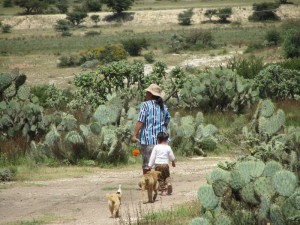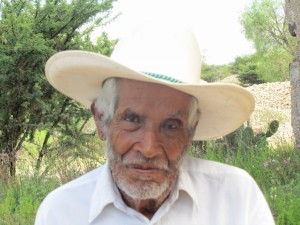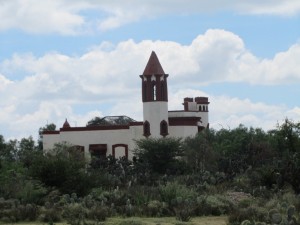Waltzing Among Ruins
In 1993, in the hottest month of the year, I donned a white paper maché mask, and a long black dress and headed to Pozos, an abandoned silver mining town high in the Sierra Madre Mountains. Among the ruins of long forgotten homes, a dark, handsome stranger took me in his arms and we started to dance.
I know this sounds intriguing, even magical, however we were not alone. The camera was rolling and recording our every move. Illusions of intimacy were further diminished by the four identically dressed couples weaving between us as Leonard Cohen sang, “Take this Waltz”. We moved with care, surrounded by cactus of every size and shape, as well as open, unmarked mine shafts, which plummeted 200 feet into a dark abyss of icy water.
Mineral de Pozos, a working town of 70,000 during the 19th century, was a picturesque ghost town known for hiking, exploring and the occasional tidy disposal of dead bodies by the time we arrived to film a music video. The flooded shafts and lack of witnesses earned Pozos its reputation for discreet body tossing. I knew of at least one person who has taken advantage of the facilities, however his conscience got the best of him and he soon confessed to the authorities.
The ruins of Pozos are still standing, just as they were when I waltzed on its graveled ground. The howling wind and sweeping mountain views haven’t changed. Squatters, though, have devoured some of the crumbling stone houses, creating privacy by hanging sheets over the doors and windows. They use the large prickly pear cactus that dot the landscape to dry their clothes and the fallen mesquite trees for cooking.
Among this deserted landscape I found Don Raymundo, the town’s last living miner. He is now custodian of Santa Brigita, the area’s original mine, founded by the Franciscans in the late 16th century. He has worked on the property his entire life, starting at the age of 15, when he went down into the deep shafts to carry out 50 kilo bags of rock that were later sorted into piles of potential silver, gold and mercury.
Don Raymundo still possesses a shape mind and agile body, even though he has no idea how old he is. “Maybe 80,” he says when I pry into his personal life. In another sentence he claims to be 65, but that would conflict with his childhood memories of the Cristero War between Church and State in the 1920s.
“I was paid a peso a day,” the elderly man tells me. “It was just enough to buy corn.” The corn was then milled into masa and rolled into tortillas, which was everyone’s staple diet, along with nopal cactus and beans. Don Raymundo informed me that most miners didn’t have money for more than one set of clothes, so they crawled into the mountains naked, even in the freezing cold. Like most men of his generation, he married young, at 16, and soon had a large family to support. He claims to be one of the lucky ones though—he survived the mines and had enough to eat. Many were not so fortunate.
When I asked Don Raymundo if he has any fond memories of the old days, he looked at me with surprise and disbelief. Obviously, their depth of despair had not completely sunken in to my modern, comfortable mind. “It was a hard, grueling life. Every day we struggled just to stay alive,” he emphasized with a serious demeanor.
Waltzing among history so many years ago, I never realized the misery of the land and was glad I had a warm, cozy bed and full stomach in 2010.
Chicken a la Veracruzana
From Los Famosos de Pozos Restaurant & Savoring San Miguel Cookbook
The cuisine coming from the state of Veracruz on the Gulf Coast has a predominantly Spanish influence. When the conquistadores landed on the shores of Mexico 500 years ago, they brought olive oil, capers, and green olives. These ingredients, along with ripe, red tomatoes, which are native to the Americas, form an important part of the Veracruz kitchen. This dish substitutes chicken for the originally red snapper.
6 servings
6 boneless, skinless chicken breasts
1 tablespoon olive oil
1 white onion, sliced
4 Roma tomatoes, chopped
1 cup whole green olives
1/4 cup capers
4 whole Guero chiles
3+1 tablespoons chopped parsley
Salt and black pepper to taste
1. Place the olive oil in a large frying pan over medium-high heat. When hot, add the chicken breasts and brown on both sides. Remove.
2. Add the onion and cook until tender, about 5-8 minutes. (Add more olive oil if necessary.)
3. Add all the other ingredients along with 1 cup of water (or chicken stock). Season with salt and pepper. Cook for a few minutes. Return the chicken to the pan. Lower to medium heat, cover and cook until chicken is done, about 8-10 minutes.
4. Place cooked chicken on a platter and cover with the sauce. Garnish with the extra tablespoon of parsley.
Tags: abandoned silver mines, delicious expeditions, kris rudolph, mexican chicken recipe, Mineral de Pozos, Pozos, recipe chicken a la veracruzana, travel near San miguel






